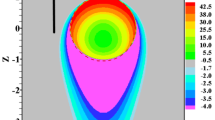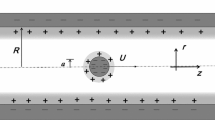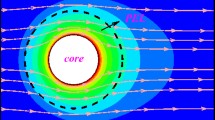Abstract
The hydrodynamic force (drag) on spherical and irregularly shaped particles significantly increases when the particles move close to solid and permeable boundaries. The overall effect of the increased hydrodynamic drag is to hinder the particle movement in the vicinity of boundaries and this includes the Brownian movement and electrophoresis. The Monte Carlo simulation method is used to model the Brownian movement, the resulting diffusion, and the electrophoresis of spherical particles in narrow, cylindrical pores, filled with Newtonian fluids. It is observed that the effect of the pore walls is a significant reduction of the space-averaged electrophoretic velocity of the particles, which implies reduced particle flux through the pores. The hindered electrophoresis is primarily a geometric phenomenon, caused by the increased drag and depends on the size of the particles and the pore-to-particle diameter ratio. The temperature of the fluid slightly affects the hindered electrophoresis through its effect on the viscosity, which is a determinant of the Brownian force, the diffusivity and the electrophoretic velocity. The hindered electrophoresis is almost independent of the other fluid and particle properties, such as density. Based on the simulation results a non-linear correlation for the flux of particles is derived, valid in the ranges 5 < R/α < 120, 5 nm < α < 100 nm and 273 K < T < 355 K.






Similar content being viewed by others
Abbreviations
- D :
-
Particle diffusivity
- E :
-
Electric field intensity
- F :
-
Force
- h :
-
Particle distance from the wall
- k B :
-
Boltzmann constant
- K :
-
Drag enhancement parameter
- m:
-
Mass
- NBE :
-
Dimensionless force
- q:
-
Surface charge of the particle
- r :
-
Radial coordinate
- R :
-
Radius of the pore
- \(\vec{R}\) :
-
Random number
- Re :
-
Reynolds number
- t :
-
Time
- T :
-
Temperature
- u :
-
Fluid velocity
- v :
-
Particle velocity
- V el :
-
Thermophoretic velocity
- V el∞ :
-
Thermophoretic velocity in an infinite medium
- z :
-
Axial coordinate
- α :
-
Particle radius
- ε :
-
Electric permittivity
- ζ :
-
Zeta-potential
- μ :
-
Dynamic viscosity
- ν :
-
Dynamic viscosity
- ρ :
-
Density
- τ :
-
Characteristic time
- av:
-
Average
- el:
-
Electrophoretic
- f:
-
Fluid
- p:
-
Particle
References
Westermeier R. Electrophoresis in practice: a guide to methods and applications of DNA and protein separations. 4th ed. London: Wiley; 2005.
Jubery KZ, Prabhu AS, Kim MZ, Dutta P. Modeling and simulation of nanoparticle separation through a solid-state nanopore. Electrophoresis. 2012;33:325–33.
Michaelides EE. Nanofluidics—thermodynamic and transport properties. New York: Springer; 2014.
Mebert AM, Tuttolomondo MV, Alvarez-Echazu MI, Foglia ML, Alvarez GS, Vescina MC, Santo-Orihuela PL, Desimone MF. Review—nanoparticles and capillary electrophoresis: a marriage with environmental impact. Electrophoresis. 2016;37:2196–207.
Michaelides EE. Hydrodynamic force and heat/mass transfer from particles, bubbles and drops—the Freeman scholar lecture. J Fluids Eng. 2003;125:209–38.
Deen WM. Hindered transport of large molecules in liquid-filled pores. AIChE J. 1987;33:1409–25.
Bird RB. five decades of transport phenomena. AIChE J. 2004;50:273–87.
Michaelides EE. Nanoparticle diffusivity in narrow cylindrical pores. Int J Heat Mass Transf. 2017;114:607–12.
Han R, Wang G, Qi S, Ma C, Yeung SE. Electrophoretic migration and axial diffusion of individual nanoparticles in cylindrical nanopores. J Phys Chem C. 2012;116:18460–8.
Goyal G, Freedman KJ, Kim MJ. Gold nanoparticle translocation dynamics and electrical detection of single particle diffusion using solid-state nanopores. Anal Chem. 2013;85:8180–7.
Detcheverry F, Bocquet L. Thermal fluctuations in nanofluidic transport. Phys Rev Lett. 2012;109:024501.
Chiavazzo E, Fasano M, Asinari P, Decuzzi P. Scaling behaviour for the water transport in nanoconfined geometries. Nat Commun. 2014;5:3565. https://doi.org/10.1038/ncomms4565.
Faxen H. Der Widerstand gegen die Bewegung einer starren Kugel in einer zum den Flussigkeit, die zwischen zwei parallelen Ebenen Winden eingeschlossen ist. Ann Phys. 1922;68:89–119.
Happel J, Brenner H. Low Reynolds number hydrodynamics. reprint. Dordecht: Martinus Nijhoff; 1986.
Pasol M, Martin L, Ekiel-Jezewska ML, Wajnryb E, Blawzdziewicz J, Feuillebois F. Motion of a sphere parallel to plane walls in Poiseuille flow. Applications to field-flow fractionation and hydrodynamic chromatography. Chem Eng Sci. 2011;66:4078–89.
Michaelides EE. Particles, bubbles and drops—their motion, heat and mass transfer. New Jersey: World Scientific Publishers; 2006.
Michaelides EE. Wall effects on the Brownian movement, thermophoresis, and deposition of nanoparticles in liquids. J Fluids Eng. 2016;138(5):051303.
Einstein A. Über die von der molekularkinetischen Theorie der Wärme geforderte Bewegung von in ruhenden Flüssigkeiten suspendierten Teilchen. Ann Phys Leipzick. 1905;17:549–60.
Li A, Ahmadi G. Dispersion and deposition of spherical particles from point sources in a turbulent channel flow. Aerosol Sci Technol. 1992;16:209–26.
Öttinger HC. Stochastic processes in polymeric fluids: tools and examples for developing simulation algorithms. Heidelberg: Springer; 1996.
Berg JC. An introduction to interfaces and colloids—the bridge to nano-science. New Jersey: World Scientific; 2010.
Russel WR, Saville DA, Schowalter WR. Colloidal dispersions. Cambridge: Cambridge University Press; 1989.
Ermak DL, McCammon JA. Brownian dynamics with hydrodynamic interaction. J Chem Phys. 1978;69:1352–60.
Grassia PS, Hinch EJ, Nitche LC. Computer simulations of Brownian motion of complex systems. J Fluid Mech. 1995;282:373–403.
Gerardi C, Cory D, Buongiorno J, Hu LW, McKrell T. Nuclear magnetic resonance-based study of ordered layering on the surface of alumina nanoparticles in water. Appl Phys Lett. 2009;95:253104.
Michaelides EE. Brownian movement and thermophoresis of nanoparticles in liquids. Int J Heat Mass Transf. 2015;81:179–87.
Holman JP. Experimental methods for engineers. 7th ed. New York: McGraw-Hill Book Co.; 2001.
Acknowledgements
This research was partly supported by the W. A. “Tex” Chair of Engineering at Texas Christian University.
Author information
Authors and Affiliations
Corresponding author
Ethics declarations
Conflict of interest
The author declares that he does not have any conflict of interest pertaining to the results of this study.
Rights and permissions
About this article
Cite this article
Michaelides, E.E. Hindered electrophoresis of nanoparticles in narrow pores. J Therm Anal Calorim 135, 1363–1371 (2019). https://doi.org/10.1007/s10973-018-7462-x
Received:
Accepted:
Published:
Issue Date:
DOI: https://doi.org/10.1007/s10973-018-7462-x




